Earth Changes & End Times
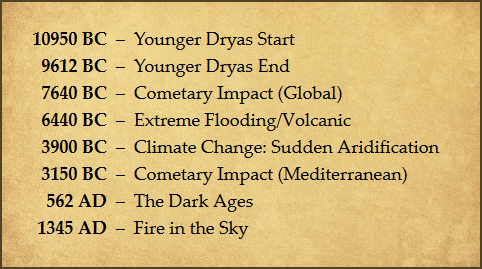
In any consideration of world age cycles - most especially associated with sudden earth changes / geophysical upheaval - it is important to consider the scientific evidence which has been amassed confirming that the Earth has indeed suffered immense catastrophe as part of its history.
In this case one is focused upon the recent history of the planet stretching back to the end of the last ice age some 13,000 years ago. To be sure, from this time up until the present the Earth has been periodically subject to colossal devastation several times, in the form of intense meteor showers, sudden climatic change, volcanic activity or extreme flooding.
The following list details some of the most notable events over the period in question; each described more fully below:
10900 BC – The Younger Dryas Event
One of the most devastating events of the recent past to have struck the Earth occurred shortly after the close of the last ice age circa 10,900 BC. A date marking the beginning of a time period known as the Younger Dryas, wherein the Earth suffered a sharp decline in temperature covering much of the northern hemisphere.
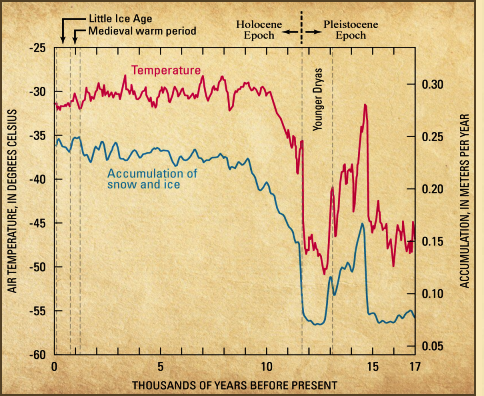
It was at this time that over a period of only a few decades or so, the temperature decreased between two and 6 degrees, even interfering with the warm flow of ocean currents; the evidence in this case resting upon ice core samples and tree ring data. Image Left
Further to this though, such changes would also appear to coincide with extreme volcanic activity. In this case the eruption of the super volcano known as Laacher See, located close to the city of Bonn in Germany. An event also dated to circa 10,900 BC (12,900 years BP - Before Present); being particularly devastating for the European continent. Here one can see cited (below) a recent research paper that examined the effects of its eruption, as simulated, and just how the event appears to have devastated the European landscape at the time.
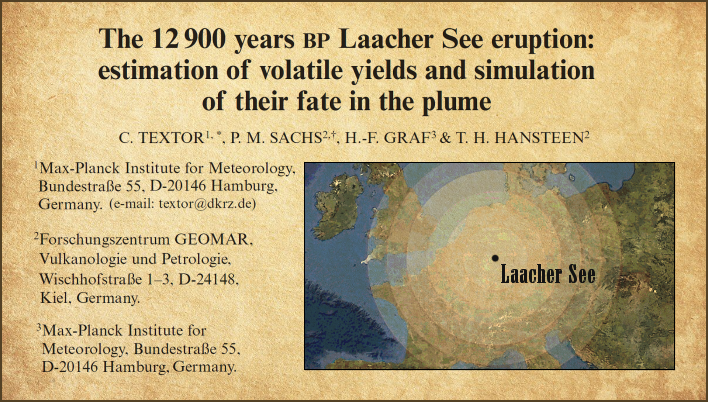
Now as one can imagine, all of these changes had a very significant impact upon life. Indeed, quite a number of notable animal species became extinct. Including mastodons, sabre-tooth tigers, camels and giant ground sloths. Even humans were affected, for as a result of the extinction of certain animal species, it is thought that the hunter gatherer societies of the time transitioned towards diets involving berries, root and much smaller game. It is even held by some scientists that this led humanity to develop agricultural practices also to survive.
Such effects of sudden climate change thus considered, it is interesting to note then just what actual caused the Younger Dryas in the first place. Herein the remarkable conclusion as set forth recently by science, is that some sort of cometary impact was responsible. Ultimately being accountable for triggering all of the effects associated with the onset of the Younger Dryas.
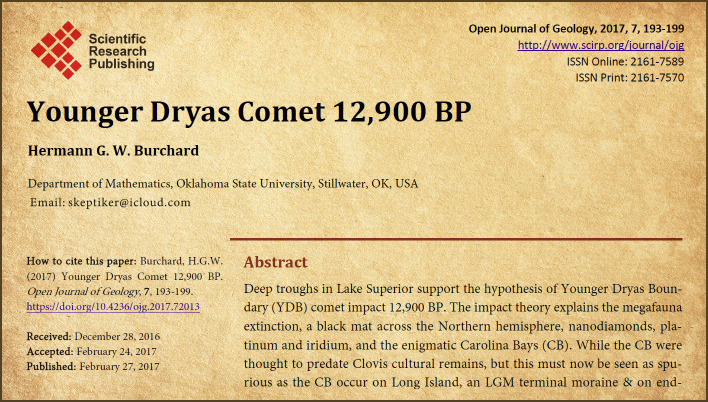
As reported at the Proceedings Of The National Academy Of Sciences, an
international group of scientists presented a case for an asteroid
impact circa 10,900 BC in the Canadian province of Québec. The impact
hypothesis not only explains the megaphone extinction, but also a
distinct black mat layer across the northern hemisphere, finding its
support also by Russian borehole data.
On one final point
concerning the beginning of the Younger Dryas era, we may note a certain
refinement as to the onset of the event based upon a study of an
archaeological site in modern-day Turkey, known as Gobekli Tepe. A
rather mysterious megalithic site containing many large carved stones
with intricate designs.
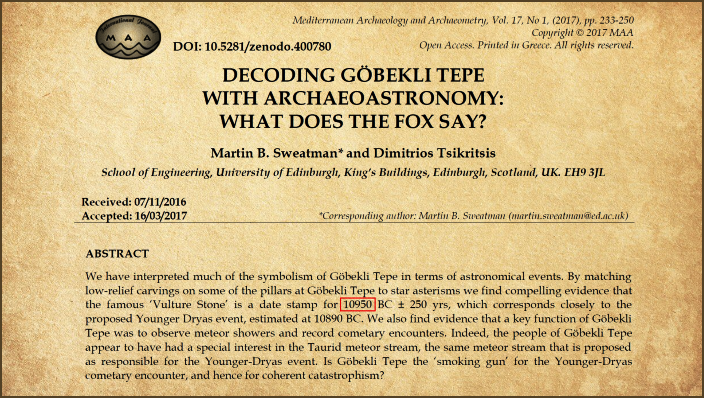
In a research paper by Sweatman & Tsikritsis (2016) entitled “Decoding Gobekli Tepe with Archaeoastronomy: what does the Fox say?” it was revealed that a key function of the site was to observe meteor showers and record cometary encounters. In this case the people who built the site would appear to have had an extreme interest in the Taurid meteor shower, which some scientists believe was actually responsible for the Younger Dryas event.
Indeed, following an evaluation of one key stone known as the ‘Vulture Stone,’ the scientists concluded based upon its star asterisms that it was an effective ‘date stamp’ for the Younger Dryas event, as caused by the Earth somehow being caught up in a meteor stream at the time. In this case the evaluation of the positions of the star positions as carved/encoded, dated the destructive event to 10,950 BC +/-250 years.
9600 BC – The Younger Dryas Event End
The next great event to consider which quite suddenly transformed the environment was the end of the Younger Dryas Period. According to a study of both ice core samples and tree ring data, the Younger Dryas period came to an end circa 9600 BC. At which time there was a sudden increase in temperature to reverse the decrease which it occurred at the beginning of the Younger Dryas era some 1300 years earlier. In this instance temperature increase was approximately 10° +/- 4° C.
Some studies examining oxygen isotopes indicated that the sudden increase in temperature occurred over a period of 40 to 50 years. Other data however examining dust concentration and snow accumulation suggest that it was much more rapid, occurring over just a few years.
In this instance or may cite five different studies that have attempted to fix the date: ice core samples and tree rings:
Years ago (i.e. Before Present, or BP):
11500 +/- 50 (GRIP ice core, Greenland)
11530 +40/-60 (Krakenes Lake, Norway)
11570 (Cariaco Basin core, Venezuela)
11570 (German oak pine, dendrochronology)
11640 +/-280 (GISP2 ice core, Greenland)
NB: All of these dates are before present BP, from the reference date of 1950 BC.
If one averages all five results, one gets a value for the end of the Younger Dryas event at 9612 BC
7640 BC – Cometary Impact
The next great earthbound disaster to consider is one that appears to have occurred in the mid-eighth millennium BC. In this case the Earth would appear to have been struck by multiple fragments from some sort of Comet or asteroid. Herein one may cite the work of a husband-and-wife team of scientists known as the Tollman's.
As detailed in the book Uriel’s Machine by Christopher Knight and Robert Lomas, evidence of the Earth being struck by significant sized cometary fragments was uncovered due to the discovery of tektites (small green glassy pebble like rocks) at various key sites around the world; being well recognised as evidence of planetary bombardment.
Herein one may consider the following quotes and diagram from Uriel’s Machine itself, wherein one can clearly see date the Tollman’s determined for the event:
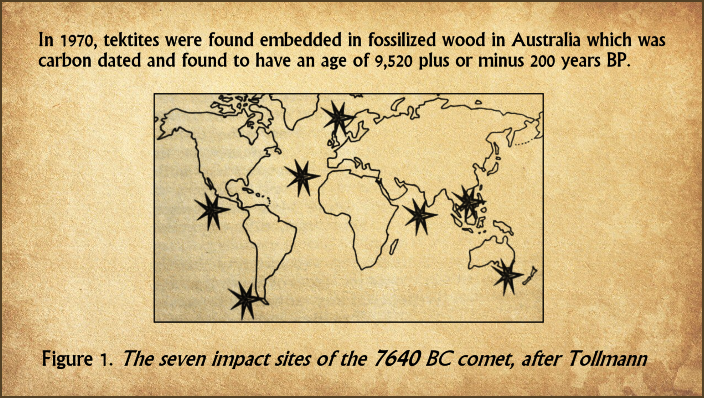
6440 BC – Extreme Flooding/Volcanic Activity
During the mid-seventh millennium BC it would appear that the Earth was affected by several highly significant geophysical events. The first noted by scientists being the formation of the English Channel. Indeed, prior to this time the British Isles would appear to have been connected to continental Europe. Herein this separation event occurred circa 6500 BC.
There is then an incident which occurred in North America dated to 6400 BC. The draining of Lake Agassiz into the oceans for the final time. An event which left lakes Manitoba, Winnipeg, Winnipegosis and Lake of the woods in the region as its remnants.
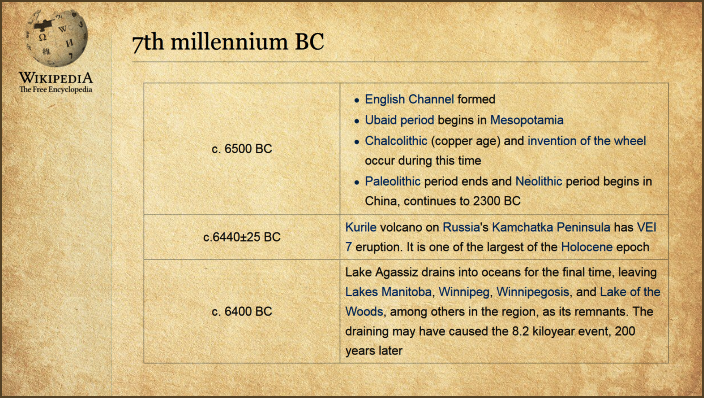
Midway between these two events there is also the eruption of a very significant volcano on Russia's Kamchatka Peninsula. An extremely powerful eruption with a VEI (Volcanic Explosivity Index) rating of 7. This being on a scale of 0 to 8 wherein eight is the most powerful volcanic explosion as classified.
Upon this scale, a rating of seven is characteristic of a volcanic eruption classed as super colossal, occurring on average once only every 500 to 1000 years. For comparison, a VEI 8 eruption is classed as mega colossal, occurring once only every 50,000 years on average. With regard to the eruption in question here then on the Kamchatka Peninsula, scientists have managed to date the event to 6440 BC +/-25 years.
As can be seen then, multiple events of great geophysical significance would appear to have occurred simultaneously in different parts of the world at the midpoint of the seventh millennium BC. Consequently, one cannot help but suspect that a single causal event lay behind them all.
3900 BC – Sudden Aridification Event
In the early years of the fourth millennium BC the geophysical history of the planet would appear to indicate that the Earth was subject to extreme climate change. And once again, as with other events previously noted, this was not something that developed gradually. To be sure, over the course of only just a few years the planet became extremely arid, producing rapid desertification.
One immediate consequence of this was mass human migration. And herein or may note the movement of people towards the Nile region, which ultimately led to the emergence of highly complex societies.
What makes this particular aridification event so notable here though, is that previous such events tended to have a fast recovery. In this instance however the 3900 BC sudden aridification event was long-lasting, without a quick recovery. At best there was only a partial recovery in the centuries that followed.
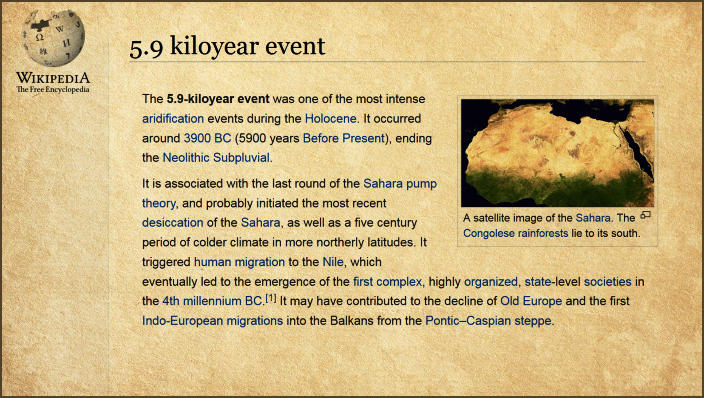
3150 BC – Cometary Impact
Here one has a very extreme event recorded within the Earth's geophysical history. What would appear to be a cometary fragment striking the Earth in the Mediterranean Sea circa 3150 BC.
In this instance the scientific evidence supporting this includes a sharp disturbance (recorded spike) to the Earth’s magnetic field; such disruptions being well-established to be clear evidence of a cometary impact event. For a detailed account of this evidence, one may consult the book Uriel’s Machine by Christopher Knight and Robert Lomas, as noted previously.
Moreover, in addition to the magnetic field data as cited by Knight and Lomas, Professor Liritzis of the University of Rhodes, acting quite independently, was able to confirm the cometary strike to the Mediterranean Sea using alternative forms of evidence.
Based upon various dating techniques, the best time estimate as determined for exactly when the event took place is 3150 BC.
One may add here that this date is very interesting in terms of its tie-ins to a number of cultures. According to orthodox scholars the Mayan Long Count calendar is said to have started in 3114 BC, marking the beginning of a new World Age. Also, under the Hindu tradition, the age of Kali Yuga is thought of commenced in 3102 BC. Further to this, in ancient Egypt, 3100 BC is also associated with the unification of the kingdom.
Following the aftermath of the cometary strike one can see then a number of cultural developments apparently associated with the event, even of an esoteric nature. That being said, these are exactly the developments which are the main focus of this present series of articles.
562 AD – The Dark Ages
Most people are broadly familiar with the onset of the dark ages in the sixth century A.D. A well recorded event associated with both plague and famine. In this regard one may cite the book by Thomas Short entitled A General Chronological History Of The Air, Whether, Seasons, And Meteors (1749 AD):
“From 562 A.D. a plague raged for 52 years the like of which has never been seen before or since.”
The effects of the plague were so severe that death usually followed after only three days from first point of infection. According to Short, in the ancient city of Constantinople (modern-day Istanbul) some 10,000 people died a day from the plague.
What is most interesting about this entire event though is that it would appear to have been associated with various strange goings-on in the heavens. To be sure, between 519 and 605 AD there were no less than nine visible comets spotted in the sky.
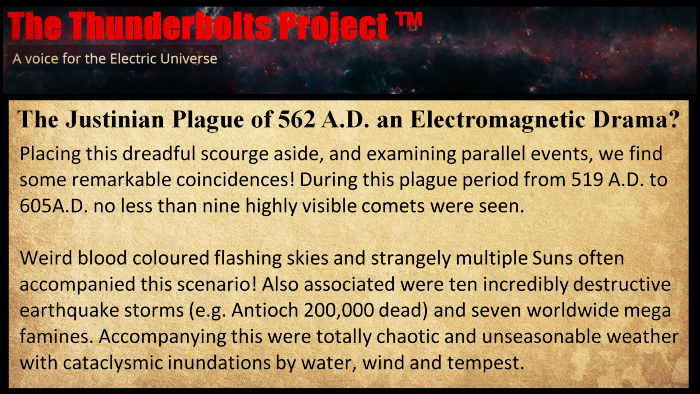
Further to this there are reports of strange multiple suns sighted, with blood coloured flashing skies. Even extreme geophysical effects were also felt, including a series of earthquake storms e.g. Antioch 200,000 dead! Chaotic weather systems with cataclysmic inundations by water, wind and also tempest.
1345 AD – Fire in the Sky
It is well established in the historical record that at the midpoint of the 14th century a massive plague swept the Earth. Within Europe it was known as the bubonic plague, or the Black death. According to certain estimates, the death toll within Europe alone was between one third and two thirds of the entire population, reaching a peak intensity between 1347 and 1351 AD. On a worldwide scale it is estimated that the death toll approached near to 100 million people.
Now what is most curious with regard to the plague is that hardly any orthodox history books mention that it was accompanied by an extremely exotic celestial occurrence. An eyewitness to the event writing in the year 1345 AD details it as follows:
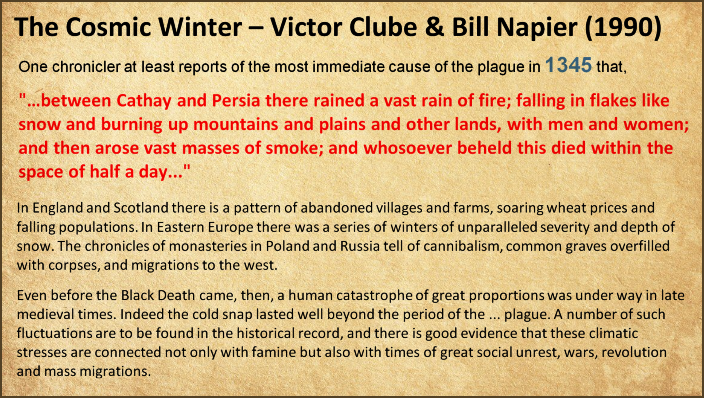
Far from being caused by fleas carried by ground rodents, as is the currently accepted orthodox theory for the origin of the plague, it would appear that it was actually something from space that caused it i.e. the plague was a space-based pathogen. And that the ‘fire in the sky’ blanketing the Earth was in fact a cometary stream (or tail) which the Earth passed through, with the actual material constituting the stream carrying the plague to humanity by way of polluting the atmosphere.
This explanation would certainly help to explain other aspects of the event that the impacted civilisation at the time. For indeed, there were also reports of extremely severe winters that occurred just prior to the onset of the plague. Unusually intense cold snaps which contributed to crop failures, leading to the abandonment of villages, cannibalism and death by famine, in addition to the subsequent death has caused by the plague itself.
A Critical Question
In view of all of the events as discussed one might be forgiven for thinking that each of them are entirely separate and unconnected. This is not the case however. There is something very special that links every single one of these events together.
And it is here that we must go into the realm of the esoteric.
Next: The World Age Ending Great Year Conjunction Pattern
Back to: Signs of the Times Menu